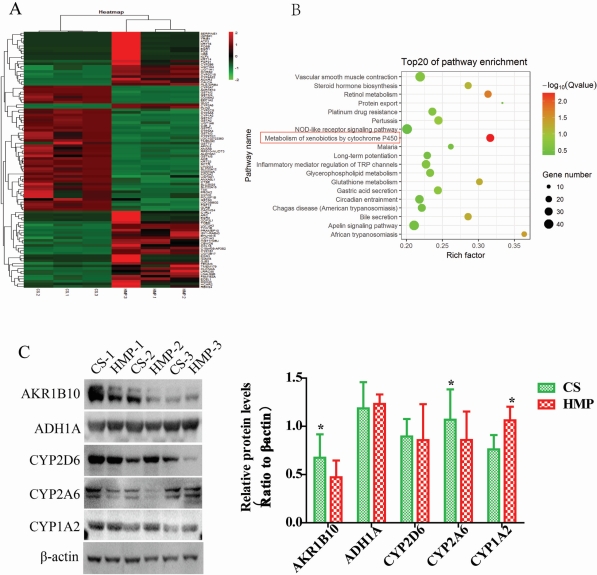Hypothermic Machine Perfusion Protects DCD Liver Graft through Metabolism of Xenobiotics by Cytochrome P450 Pathway
Q. Ye,1,2 W. Liang,1 Z. Zhong,1 S. Ye,1 B. Tang,1 Q. Hu,1 J. Liang,1 Y. Wang.1
1Transplant Center of Wuhan University, Zhongnan Hospital of Wuhan University, Wuhan, China
2The 3rd Xiangya Hospital of Central South Unversity, Changsha, China.
Meeting: 2018 American Transplant Congress
Abstract number: D292
Keywords: Gene expression, Liver metabolism, Liver transplantation, Machine preservation
Session Information
Session Name: Poster Session D: Late Breaking
Session Type: Poster Session
Date: Tuesday, June 5, 2018
Session Time: 6:00pm-7:00pm
 Presentation Time: 6:00pm-7:00pm
Presentation Time: 6:00pm-7:00pm
Location: Hall 4EF
Background: Donation after cardiac death (DCD) is the mainly resource to relieve organ-transplantation shortage. Our previous research have confirmed that the function of DCD liver grafts can be well preserved by using Hypothermic machine perfusion(HMP) so as to get a significantly transplantation outcome, however, the mechanism in it is unknown.
Methods: We collected liver tissues from three cold storage(CS) human liver grafts and three human liver grafts with 2 hours HMP and detected the gene expression with BGISEQ-500-RNAseq technique, GO and KEGG pathway enrichment analysis were used to detect and the differentiation genes were analyzed. Then, western blot was used to verified the differentiation genes corresponding proteins in the most notable pathway.
Results: BGISEQ-500-RNAseq data showed that more than one hundred of genes had more than 5-fold change in these two groups, GO and KEGG pathway enrichment analysis revealed that nineteen pathways had statistical significance (P<0.05), while, the most notable one is the metabolism of xenobiotics by cytochrome P450. Then, we further detected the corresponding proteins in this pathway, it showed that AKR1B10, CYP2A6 were down-expression, while CYP1A2 was up-expression in HMP groups .
.
Conclusion: we have confirmed that the metabolism of xenobiotics by cytochrome P450 was the the most notable pathway, and the corresponding proteins detecting also verified, while this pathway can be acted as a vital role to protected liver from oxidative injury. So we concluded that HMP can protect DCD liver graft through this pathway.
Figure legend:A, Gene enrichment analysis showed that more than one hundred of genes had 5-fold change between CS and HMP groups. B, GO and KEGG pathway enrichment analysis revealed that nineteen pathways had statistical significance (P<0.05), and the most notable one is the metabolism of xenobiotics by cytochrome P450. C, western blot was used to verified the corresponding proteins. * denotes P < 0.05 compared to CS.
CITATION INFORMATION: Ye Q., Liang W., Zhong Z., Ye S., Tang B., Hu Q., Liang J., Wang Y. Hypothermic Machine Perfusion Protects DCD Liver Graft through Metabolism of Xenobiotics by Cytochrome P450 Pathway Am J Transplant. 2017;17 (suppl 3).
To cite this abstract in AMA style:
Ye Q, Liang W, Zhong Z, Ye S, Tang B, Hu Q, Liang J, Wang Y. Hypothermic Machine Perfusion Protects DCD Liver Graft through Metabolism of Xenobiotics by Cytochrome P450 Pathway [abstract]. https://atcmeetingabstracts.com/abstract/hypothermic-machine-perfusion-protects-dcd-liver-graft-through-metabolism-of-xenobiotics-by-cytochrome-p450-pathway/. Accessed December 25, 2025.« Back to 2018 American Transplant Congress
